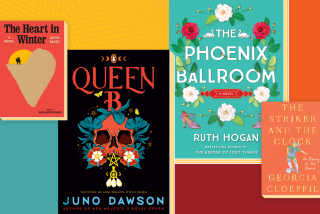Anticipation is high for Harper Lee’s ‘Go Set a Watchman.’ Will it live up to ‘To Kill a Mockingbird’?
It’s the biggest literary surprise of the 21st century: On July 13, 55 years after the publication of “To Kill a Mockingbird,” the reclusive 89-year-old Harper Lee will publish her second book.
“Go Set a Watchman” was written two years before “Mockingbird” — and details of the plot are scarce. But eager readers have, nonetheless, propelled the novel to the top of bestseller lists with advance sales. Harper, an imprint of HarperCollins, has ordered an initial print run of 2 million copies; that’s 750,000 copies more than this year’s biggest-selling novel, E.L. James’ “Grey.”
“People want more Harper Lee,” says Sherri Gallantine, the book buyer for Vroman’s and Book Soup. She’s ordered 842 copies of “Watchman,” three times more than the order for fall’s big novel, “Purity” (don’t tell Jonathan Franzen).
At the Los Angeles Public Library, 1,200 people have signed up on the wait list for print, audio and e-book copies of “Watchman.” It’s No. 1 on Amazon, where it has been on the top 10 bestseller list since February, when the title was announced.
Across the country, Lee’s fans are preparing celebrations for the arrival of a novel few knew existed just months ago.
MORE: 23 fiction books you’ll want to read -- and share -- this summer
Barnes & Noble stores will host “Mockingbird” read-a-thons on July 13. New York’s 92nd Street Y will have actress Mary Badham, who played the lead character in the 1962 movie adaptation of “To Kill a Mockingbird,” read from “Mockingbird” and “Watchman,” an event that will also stream live online.
Lee’s hometown of Monroeville, Ala., plans walking tours and a marathon reading in the former courthouse. And an updated version of Mary McDonagh Murphy’s documentary film “American Masters: Harper Lee” will air on PBS on July 10; later in the month, it will be released on iTunes and DVD as “Harper Lee: From Mockingbird to Watchman.”
“Go Set a Watchman” is a publishing phenomenon — yet almost no one has seen it. The frenzied anticipation is fueled largely by the unique place “To Kill a Mockingbird” holds in American culture: It’s beloved by millions, critically acclaimed and still relevant.
The story of injustice, racism and honor in a small Southern town was awarded the Pulitzer Prize in 1961; its film adaptation won three Oscars. Thanks in part to its perennial appearance on school syllabuses, it has sold more than 40 million copies. The story’s iconic characters — young Scout, noble Atticus Finch, the loner Boo Radley — have entered our vernacular.
“‘To Kill a Mockingbird’ is probably just as important now as it was then,” says Michael Silverblatt, host of KCRW-FM’s “Bookworm.” He sees it as the kind of book that “strengthened the soul of a nation.”
How could “Watchman,” which is set in the 1950s and tells the story of an adult Scout Finch who returns home to the fictional town of Maycomb, live up to its predecessor?
Few people have been given access to the novel. Making books available for advance reviews is usually part of the normal ramp-up to a title’s release, except in cases where there are big spoilers or fear that the critiques may be extremely harsh.
Instead, four days before its release, Harper will be giving the public a sample of the book. The first chapter of “Watchman” will run in two newspapers on July 10: the Wall Street Journal (which, like the book’s publishing house, is owned by Rupert Murdoch) and the Guardian in Britain.
Lee, who withdrew from public life, never published another book and hasn’t given a formal interview since 1964. The author was assumed to be one-hit wonder by the literary world — even Lee’s longtime attorney, her older sister, thought she was done with publishing.
Filmmaker Murphy recalls that when she interviewed Alice Finch Lee, who died in 2014 at 103 but was still practicing law at age 100, “She said she did not believe there were any other novels. I put that in my movie,” Murphy says. “What I think Alice didn’t know was there was another manuscript sitting underneath other manuscripts.”
According to the book’s publisher, Lee’s current attorney, Tonya Carter, was checking on the original manuscript of “To Kill a Mockingbird,” which is held in a secret location in Monroeville, and found the pages of “Go Set a Watchman” attached to the back of it last year.
This discovery has been steeped in controversy. Lee suffered a stroke in 2007 and, according to various legal documents, is partially blind, deaf and easily manipulated, prompting speculation about whether she has been a full participant in the decision to publish this book. The Alabama Securities Commission investigated allegations of elder abuse but found no reason to intervene.
Further questions swirled around the timing of the discovery: Why did it surface only months after Lee’s attorney and sister Alice died? And was the manuscript a forgotten novel or an early draft of “To Kill a Mockingbird”?
A statement released by Lee’s attorney in February suggested the latter. It quoted Lee as saying, “In the mid-1950s, I completed a novel called ‘Go Set a Watchman.’ It features the character known as Scout as an adult woman and I thought it a pretty decent effort. My editor, who was taken by the flashbacks to Scout’s childhood, persuaded me to write a novel from the point of view of the young Scout. I was a first-time writer, so I did as I was told.”
Charles Shields, author of 2006’s “Mockingbird: A Portrait of Harper Lee,” considered the most complete biography of the author, said that while digging through Columbia University’s publishing archives, he saw literary agent notecards showing that a manuscript titled “Go Set a Watchman” was submitted to them; later, the title was crossed out and changed to “To Kill a Mockingbird.”
If Shields could talk to Lee, he says, “I’d ask, ‘Why are you bringing it out now?’”
Among the few who’ve read the manuscript is Harper publisher Jonathan Burnham.
“It’s clearly very close to Harper Lee in terms of her life,” he says. Lee long ago acknowledged that she based Atticus on her father, A.C. Lee, Dill on her friend Truman Capote and the town of Maycomb on Monroeville.
Lee recently had a private lunch in Monroeville with her publishers and agent. Dispelling rumors about her lack of well-being, Burnham said, “She’s excited about the release.”
Aside from questions about how this book came to exist and why it’s taken so long to reach the public, there is the issue of taste: Will the views of a shy Southern writer in the late 1950s stand up to contemporary scrutiny?
For those who remember and adore “To Kill a Mockingbird,” the opportunity to revisit Atticus and Scout is likely too tempting to pass up.
“The idea that you get to find out what happened to Scout, or you get to see Atticus again — these are tantalizing things, and, of course, you want to know more,” says Murphy.
When readers crave more from the writers they love, publishers comply. Novels by F. Scott Fitzgerald, Ernest Hemingway and Vladimir Nabokov were all published after their deaths.
“Invisible Man” author Ralph Ellison, who, like Harper Lee, never followed up his classic with another novel, struggled for years to complete one. After his death, an untitled manuscript – which filled 27 boxes – was published in two forms: a truncated edited version which was considered not to meet his vision and an 1100-page version that revealed all the narrative dead ends he’d never fixed.
Unlike those authors, Lee — however reclusive — is still alive, making “Watchman” unprecedented. “There’s nothing quite like this,” Burnham says.
[email protected]
MORE FROM BOOKS:
Get ready to be obsessed by these 29 page-turners
27 nonfiction books you’ll want to read -- and share -- this summer
Listen up: Here are 11 audiobooks you’ll want to ‘read’ this summer
More to Read
Sign up for our Book Club newsletter
Get the latest news, events and more from the Los Angeles Times Book Club, and help us get L.A. reading and talking.
You may occasionally receive promotional content from the Los Angeles Times.







